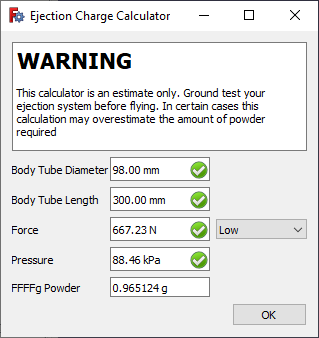Rocket Ejection Charge Calculator
|
|
| Menu location |
|---|
| Rocket → Calculators → Ejection Charge Calculator |
| Workbenches |
| Rocket Workbench |
| Default shortcut |
| None |
| Introduced in version |
| 0.19 |
| See also |
| None |
Description
ALWAYS ground test your rocket before flying
Ejection occurs when the chamber containing the recovery system is pressurized with sufficient force to eject the recovery system from the chamber. The force required can vary according to a number of factors:
- diameter and volume of the body tube
- mass of the nose and recovery system
- ejection method, for example piston systems require less pressure
- presence of shear pins used to prevent drag separation
- fit of the recovery system in the body tube
As such, this calculator will only give you a starting estimate. Too little powder will result in a failed ejection and a failed recovery. Too much powder may result in damage to the rocket or recovery system, which may also result in a failed recovery. It is ALWAYS necessary to do a ground test before flying your rocket.
When calculating the volume of the body tube, it is rarely necessary to include the full length. For example, the shoulder of the nose or electronics bay may consume some volume. Adjust your length specification accordingly.
There are some rules of thumb that can be applied based on years of experience from multiple rocket builders. Of primary concern here is the force applied to the ejectable portion, typically the nose cone or electronics bay. Ejection forces at this interface should be between 150 and 200 lbf (~667 to 890 N). The pressure required can then be calculated based on the volume of the chamber. This pressure will be less for larger diameters and more for smaller diameters. There are presets in the calculator to set these forces (low and high settings in the combobox).
Ground testing should start at the low end of the recommended range to prevent damage to your rocket. Increase the amount as required to ensure safe recovery.
Usage
- There are several ways to invoke the command:
- Press the
Ejection Charge Calculator button.
- Select the Rocket → Calculators →
Ejection Charge Calculator option from the menu.
- Press the
- Enter the weight of your rocket and parameters for your parachute.
Calculation
Pressure is set by desired force, or force can be set by specifying the desired pressure. This is based on the force applied to the area at the end of the volume to be pressurized.
where
- desired force
- body tube diameter
- desired force
Once the desired pressure is known, the amount of black powder can be calculated using
where
- the pressure calculated in the previous equation
- the volume of the chamber to be pressurized
- , combustion gas constant for FFFFg black powder
- , combustion gas temperature
- , acceleration due to gravity
- the pressure calculated in the previous equation
Units
Calculations are done using metric units, but will display in your preferred units. Values can also be entered using any supported units by including the units with the value (eg 5 oz, or 23.2 g)
References
- http://vernk.com/EjectionChargeSizing.htm
- https://www.insanerocketry.com/blackpowder.html
- https://rocketrycalculator.com/rocketry-calculator/bp-estimator
- http://www.rockethead.net/black_powder_calculator.htm
- http://hararocketry.org/hara/resources/how-to-size-ejection-charge/
- Getting started
- Installation: Download, Windows, Linux, Mac, Additional components, Docker, AppImage, Ubuntu Snap
- Basics: About FreeCAD, Interface, Mouse navigation, Selection methods, Object name, Preferences, Workbenches, Document structure, Properties, Help FreeCAD, Donate
- Help: Tutorials, Video tutorials
- Workbenches: Std Base, Assembly, BIM, CAM, Draft, FEM, Inspection, Material, Mesh, OpenSCAD, Part, PartDesign, Points, Reverse Engineering, Robot, Sketcher, Spreadsheet, Surface, TechDraw, Test Framework
- Hubs: User hub, Power users hub, Developer hub









